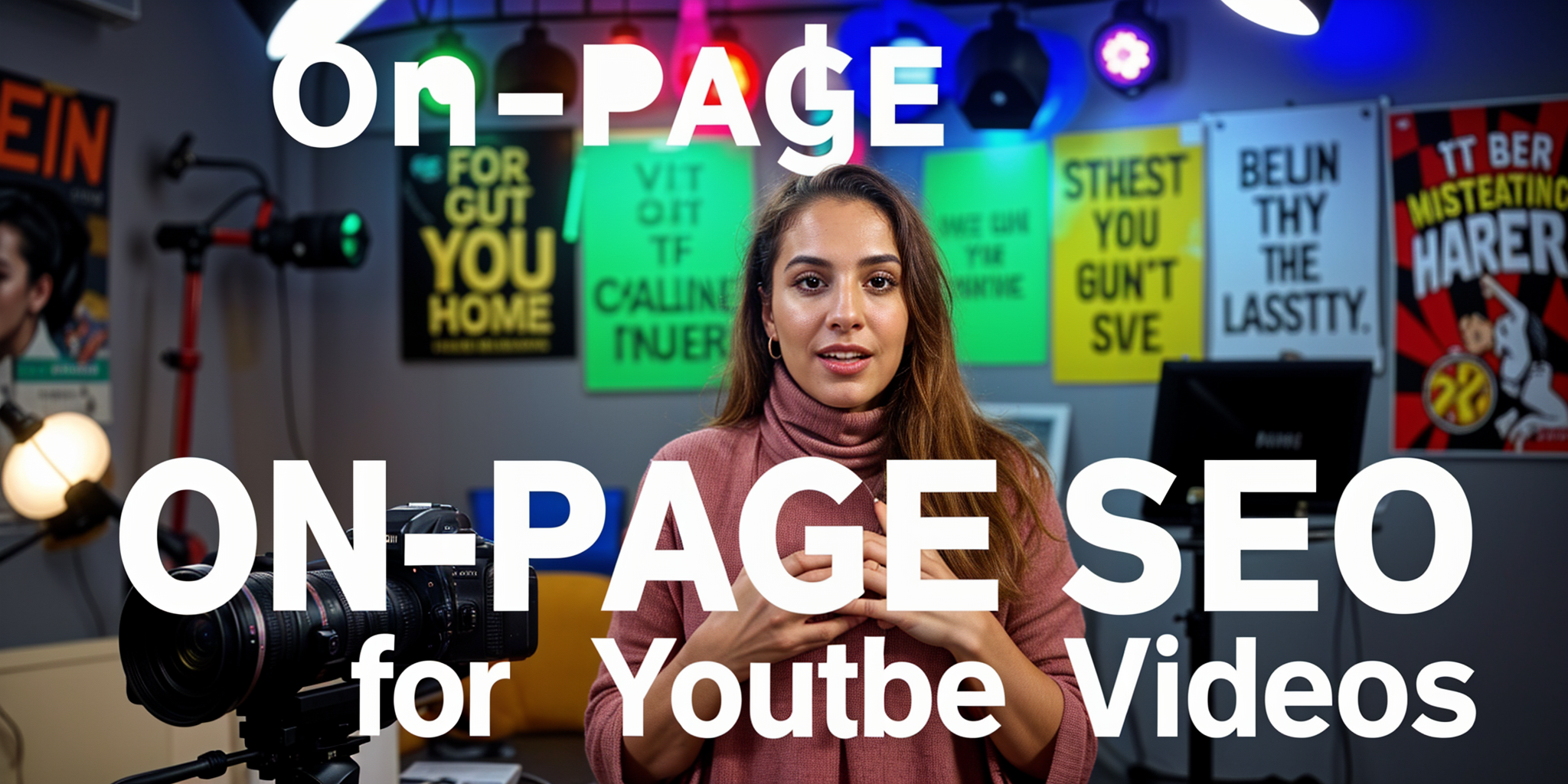On-Page SEO for YouTube Videos: Boosting Your Video Rankings
 Vishal Sahani
Vishal SahaniTable of contents
- Understanding On-Page YouTube SEO
- 1. Keyword Research: The Foundation of YouTube SEO
- 2. Compelling Video Titles: Hook Your Viewers
- 3. Informative Video Descriptions: Sell Your Content
- 4. Relevant Video Tags: Categorize Your Content
- 5. Engaging Thumbnails: Entice Clicks
- 6. Captivating Introductions: Keep Viewers Engaged
- 7. High-Quality Video Content: Deliver Value
- 8. Closed Captions and Transcripts: Improve Accessibility
- 9. End Screens and Cards: Promote Engagement
- 10. Encourage Engagement: Build a Community
- 11. Optimize for Mobile: Cater to a Growing Audience
- 12. Promote Your Videos: Reach a Wider Audience
- 13. Analyze and Optimize: Track Your Progress

YouTube isn't just a platform for sharing funny cat videos or vlogs; it's a powerful search engine in its own right. With over 2 billion logged-in monthly users, it's the second-largest search engine globally, right after its parent company, Google. If you're serious about getting your videos discovered, you need to master YouTube SEO, and On-Page optimization is where it all begins.
Understanding On-Page YouTube SEO
On-Page SEO for YouTube involves optimizing the elements within your control to make your videos more appealing to both the YouTube algorithm and your target audience. It's about understanding what your viewers are searching for and crafting your video content and metadata to align with those searches.
Let's dive deep into the key components of On-Page YouTube SEO and how you can leverage them to boost your video rankings.
1. Keyword Research: The Foundation of YouTube SEO

Keyword research is the cornerstone of any successful SEO strategy, and YouTube is no exception. It involves identifying the terms and phrases your target audience is using to search for videos on YouTube.
Here are some tools and techniques you can use for YouTube keyword research:
YouTube Search Suggest: Start typing your main topic into the YouTube search bar and see what suggestions pop up. These are popular search terms related to your topic.
YouTube Search Results: Look at the top-ranking videos for your target keywords. Pay attention to their titles, descriptions, and tags to get insights into what's working.
Keyword Research Tools: There are many free and paid keyword research tools available, such as Google Keyword Planner, Ahrefs, SEMrush, and TubeBuddy. These tools can provide you with valuable data on search volume, competition, and related keywords.
Competitor Analysis: Analyze the top-performing videos in your niche. Look at their titles, descriptions, tags, and overall content strategy.
Once you've identified your target keywords, it's time to strategically incorporate them into your video's metadata and content.
2. Compelling Video Titles: Hook Your Viewers
Your video title is the first thing people will see, so make it count. It should be attention-grabbing, relevant to your content, and include your target keyword.
Here are some tips for writing compelling video titles:
Keep it concise: Aim for 50-60 characters to ensure your title displays fully in search results.
Include your target keyword: Ideally, place your keyword at the beginning of the title.
Spark curiosity: Use intriguing language or pose a question to entice viewers to click.
Be accurate: Avoid clickbait titles that mislead viewers about your content.
3. Informative Video Descriptions: Sell Your Content
Your video description provides more context about your video and helps YouTube understand its content. It's also an opportunity to include additional keywords and encourage viewers to take action.
Here's how to write effective video descriptions:
Front-load important information: The first few lines of your description are the most visible in search results, so include your target keyword and a compelling summary of your video.
Use relevant keywords: Sprinkle additional keywords throughout your description to improve its visibility in search.
Include calls to action: Encourage viewers to like, comment, subscribe, or visit your website.
Add links: Include links to relevant resources or your social media profiles.
Consider length: While there's no strict limit, aim for at least 200-300 words to provide ample context for YouTube and viewers.
4. Relevant Video Tags: Categorize Your Content
Video tags help YouTube categorize your content and understand its relevance to specific searches. Use a mix of broad and specific tags to ensure your video reaches the right audience.
Here are some tips for choosing video tags:
Include your target keyword: Make sure your primary keyword is included as a tag.
Use related keywords: Add variations and synonyms of your target keyword to broaden your reach.
Consider competitor tags: Look at the tags used by top-ranking videos in your niche.
Don't overdo it: Stick to a reasonable number of tags (5-10) to avoid confusing the algorithm.
5. Engaging Thumbnails: Entice Clicks

Your video thumbnail is a visual representation of your content and plays a crucial role in attracting clicks. A compelling thumbnail can significantly increase your video's click-through rate (CTR), which is a key ranking factor on YouTube.
Here are some tips for creating engaging thumbnails:
Use high-quality images: Ensure your thumbnail is visually appealing and high-resolution.
Include relevant text: Add a brief title or call to action to reinforce your message.
Be consistent: Maintain a consistent style and branding across all your thumbnails.
Test different options: Experiment with different images and text to see what performs best.
6. Captivating Introductions: Keep Viewers Engaged
The first few seconds of your video are critical for capturing viewers' attention and preventing them from bouncing. A strong introduction will hook them in and encourage them to watch the entire video.
Here's how to create captivating introductions:
Start with a bang: Pose a question, share a surprising fact, or tell a brief story to pique interest.
Highlight the value: Clearly communicate what viewers will gain from watching your video.
Tease the content: Give a sneak peek of what's to come without giving too much away.
Keep it concise: Aim for a 10-15 second introduction to maintain momentum.
7. High-Quality Video Content: Deliver Value
Ultimately, the quality of your video content is the most important factor in determining its success on YouTube. If your videos are informative, engaging, and valuable to your audience, they're more likely to be watched, shared, and recommended by the algorithm.
Here are some tips for creating high-quality video content:
Focus on your niche: Create videos that cater to the interests and needs of your target audience.
Tell a story: Use storytelling techniques to make your videos more compelling and memorable.
Use visuals effectively: Incorporate graphics, animations, and b-roll footage to enhance your message.
Optimize audio quality: Ensure your audio is clear and free of background noise.
Edit professionally: Cut out any unnecessary footage and ensure a smooth flow.
End with a call to action: Encourage viewers to like, comment, subscribe, or share your video.
8. Closed Captions and Transcripts: Improve Accessibility
Adding closed captions and transcripts to your videos not only improves accessibility for viewers with hearing impairments but also provides additional text for YouTube to index, which can improve your video's visibility in search results.
You can either create captions and transcripts manually or use YouTube's automatic captioning feature, although it's recommended to review and edit the automatic captions for accuracy.
9. End Screens and Cards: Promote Engagement
End screens and cards are interactive elements you can add to your videos to promote other videos, playlists, channels, or external websites. They're a great way to keep viewers engaged and encourage them to take further action.
Use end screens to:
Suggest related videos: Keep viewers watching your content by recommending other relevant videos.
Promote your channel: Encourage viewers to subscribe to your channel.
Link to external websites: Drive traffic to your website or landing page.
Use cards to:
Highlight other videos or playlists: Draw attention to specific content within your channel.
Poll your audience: Gather feedback and insights from your viewers.
Link to merchandise or crowdfunding campaigns: Promote products or initiatives related to your content.
10. Encourage Engagement: Build a Community
Engagement signals, such as likes, comments, shares, and watch time, play a significant role in YouTube's ranking algorithm. The more viewers interact with your videos, the more likely YouTube is to recommend them to others.
Here are some ways to encourage engagement:
Ask questions: Prompt viewers to share their thoughts and opinions in the comments.
Respond to comments: Engage in conversations with your viewers and build relationships.
Run contests or giveaways: Incentivize viewers to interact with your content.
Collaborate with other creators: Partner with other YouTubers to reach a wider audience.
Host live streams: Interact with your viewers in real-time and foster a sense of community.
11. Optimize for Mobile: Cater to a Growing Audience
With the majority of YouTube views now happening on mobile devices, it's essential to ensure your videos are optimized for smaller screens.
Here are some tips for optimizing your videos for mobile:
Use large, clear text: Make sure any text in your videos is easy to read on mobile devices.
Keep visuals simple: Avoid cluttering your videos with too many elements.
Use vertical video formats: Consider creating videos in vertical formats, such as 9:16, for platforms like Instagram Reels and TikTok.
Test on mobile devices: Preview your videos on different mobile devices to ensure they look and function correctly.
12. Promote Your Videos: Reach a Wider Audience
While On-Page SEO is crucial, it's equally important to promote your videos off YouTube to attract more viewers and engagement.
Here are some ways to promote your videos:
Share on social media: Post your videos on your other social media profiles and encourage your followers to watch and share them.
Embed in blog posts: Include your videos in relevant blog posts to provide additional context and value.
Email your subscribers: Send your latest videos to your email list and encourage them to check them out.
Run paid ads: Consider using YouTube Ads or other advertising platforms to reach a wider audience.
Collaborate with influencers: Partner with influencers in your niche to promote your videos to their followers.
Submit to relevant websites and forums: Share your videos on websites and forums related to your niche.
13. Analyze and Optimize: Track Your Progress

YouTube Analytics provides valuable insights into your video performance, including views, watch time, audience demographics, traffic sources, and more. Use this data to identify what's working and what's not, and make adjustments to your strategy accordingly.
Here are some key metrics to track:
Views: The total number of times your video has been viewed.
Watch time: The total amount of time viewers have spent watching your video.
Audience retention: The percentage of your video that viewers watch on average.
Click-through rate (CTR): The percentage of people who clicked on your video thumbnail after seeing it in search results or suggested videos.
Engagement: The number of likes, comments, shares, and subscribers your video receives.
Traffic sources: Where your viewers are coming from (e.g., YouTube search, suggested videos, external websites).
Regularly analyze your data and experiment with different On-Page optimization techniques to see what resonates best with your audience and drives the most engagement.
Conclusion
Mastering On-Page SEO for YouTube videos is essential for boosting your video rankings and reaching a wider audience. By conducting thorough keyword research, optimizing your video titles, descriptions, tags, and thumbnails, creating high-quality content, and promoting your videos effectively, you can significantly increase your visibility and engagement on the platform.
Remember that YouTube SEO is an ongoing process. Stay up-to-date with the latest trends and algorithm changes, experiment with different strategies, and continuously analyze your data to refine your approach and achieve long-term success.
Key Takeaways:
Keyword research is fundamental: Identify the terms your target audience is searching for and incorporate them strategically.
Craft compelling titles and descriptions: Grab attention and provide context for both viewers and the algorithm.
Use relevant tags: Help YouTube categorize your content and improve its discoverability.
Create engaging thumbnails: Entice clicks and increase your CTR.
Focus on high-quality content: Deliver value to your audience and keep them coming back for more.
Encourage engagement: Foster a community and interact with your viewers.
Optimize for mobile: Cater to the growing number of mobile viewers.
Promote your videos: Share your content on other platforms and reach a wider audience.
Analyze and optimize: Track your progress and make data-driven decisions.
By following these best practices and staying committed to creating valuable content, you can unlock the full potential of YouTube and achieve your video marketing goals.
Subscribe to my newsletter
Read articles from Vishal Sahani directly inside your inbox. Subscribe to the newsletter, and don't miss out.
Written by

Vishal Sahani
Vishal Sahani
I'm a freelance digital marketing and SEO expert dedicated to helping businesses thrive online. From crafting compelling content to building high-performing WordPress websites and managing social media, I offer a comprehensive suite of services designed to boost your visibility, engage your audience, and drive tangible results. Let's transform your digital presence and achieve your business goals together.